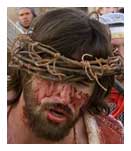One of the main rules in Hollywood is not to finance your own films. And, only six out of ten movies ever make a profit. Filmmaking is, in many ways, a brutal business.

When Mel Gibson first looked for financing for The Passion of the Christ, no one would underwrite his movie. Gibson’s purpose for making the film was, ostensibly, to give viewers a new take on the life of Christ. Gibson identifies himself as a religious man and this film was, apparently, his attempt to share his beliefs with the movie-going public. But, movies are meant, after all, to turn a profit. Finding no outside support, Gibson financed The Passion out of his own pocket. A moderately expensive movie to make, with no guarantees of commercial success, The Passion was initially seen as a huge risk for Gibson. After completion of the film, he struggled to find a studio to distribute it.
In the end, Gibson’s risk certainly paid off. Financial analysts of the film industry estimate that he has so far netted about $81 million, after expenses.
The style of this widely controversial film should not come as a surprise to anyone, considering other films such as Braveheart (1995) that Gibson also directed. The same fierce bloody style in The Passion is, in part, what has kept many otherwise interested viewers from seeing the film.
A lot that is in The Passion is not in the Bible. To really understand the film, a background in world history is needed. For instance, if Jesus had been Roman, the Roman soldiers would not have touched him at his trial. All that Jesus would have had to do was say: “I appeal” and he would have been sent to Rome – just like Paul had been.
Paul, because he was Roman, could not be put to death by crucifixion – it was considered a fate far too cruel for one with Roman blood in his veins. If you weren’t a Roman citizen, the sentence by the Prefect (Pontius Pilate) was carried out after the trial – there was no chance for appeal. The tormenting of the prisoners by the guards was part of the Roman tradition. Crucifixion was meant to be a slow painful death as a deterrent to others who might defy Rome.
In addition to the bloody nature of much of the film, some of Gibson’s filmmaking techniques also elicited feedback from moviegoers. In one scene, at the end of the movie, Mary looks directly into the camera. This technique generally is not used because it creates a direct connection between a character and the audience that skews the usual relationship, making the shot more of an “interview” format or even an aside. This haunting stare by Mary, who is at the time in the forefront of the scene, seems to be her condemnation of the viewers, blaming them for the death of her son.
The Passion, for a variety of reasons, is a movie that continues to raise more questions than it answers. One of many split reactions to the film is by religious liberals and conservatives. Another, that Gibson’s film roused slumbering anti-Semitic views when he showed the Jewish religious leaders conspiring to have Christ killed. “Some Protestants have reacted badly to the film’s dependence on such Catholic traditions as if the film is somehow a polemic for Catholicism, which certainly it is not. What Gibson seemed to do in the Passion is find in the patterning of the Stations of the Cross a structure for the screenplay, and a point of view for the camera.”
These and many other aspects of the film are far too complex to fully consider here. The reader would be well-served by reading “Sounding Out The Passion of the Christ” by Dr. Peter Fraser, originally published in the Summer 2004 issue of CHARIS.
